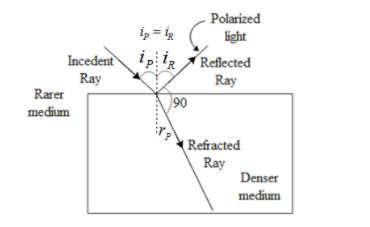
What is the Brewster angle for air to glass transition? (Refractive index of glass = 1.5)
Answer
498.6k+ views
Hint: Brewster angle is also called the polarizing angle. It is defined as the angle of incidence for which a beam of unpolarised light falling on a transparent surface is reflected as a beam of completely plane polarized . The refracted ray and the reflected ray makes an angle 90 with each other. Hence using Snell’s law we can obtain the Brewster angle in terms of refractive index and glass and determine the angle of polarization.
Complete answer:

In the above figure the reflected ray makes an angle 90 degrees with the refracted ray. The Denser medium is the glass and the rarer medium surrounding it is air. Let us say the reflected ray makes an angle
From Snell’s law, the refractive index of the glass is given by,
The refractive index of glass is given as 1.5. After substituting in equation 2 we get,
Hence the Brewster angle for glass is 56.3 degrees.
Note: The angle of incidence for which the reflected light will get polarized depends on the medium on which the light is incident on. To be more precise, it also depends on both the mediums, the rarer as well as the denser. The effect of a polarized light is that the intensity of the light decreases.
Complete answer:

In the above figure the reflected ray makes an angle 90 degrees with the refracted ray. The Denser medium is the glass and the rarer medium surrounding it is air. Let us say the reflected ray makes an angle
From Snell’s law, the refractive index of the glass is given by,
The refractive index of glass is given as 1.5. After substituting in equation 2 we get,
Hence the Brewster angle for glass is 56.3 degrees.
Note: The angle of incidence for which the reflected light will get polarized depends on the medium on which the light is incident on. To be more precise, it also depends on both the mediums, the rarer as well as the denser. The effect of a polarized light is that the intensity of the light decreases.
Latest Vedantu courses for you
Grade 10 | MAHARASHTRABOARD | SCHOOL | English
Vedantu 10 Maharashtra Pro Lite (2025-26)
School Full course for MAHARASHTRABOARD students
₹31,500 per year
Recently Updated Pages
Express the following as a fraction and simplify a class 7 maths CBSE

The length and width of a rectangle are in ratio of class 7 maths CBSE

The ratio of the income to the expenditure of a family class 7 maths CBSE

How do you write 025 million in scientific notatio class 7 maths CBSE

How do you convert 295 meters per second to kilometers class 7 maths CBSE

Write the following in Roman numerals 25819 class 7 maths CBSE

Trending doubts
State and prove Bernoullis theorem class 11 physics CBSE

What are Quantum numbers Explain the quantum number class 11 chemistry CBSE

Write the differences between monocot plants and dicot class 11 biology CBSE

1 ton equals to A 100 kg B 1000 kg C 10 kg D 10000 class 11 physics CBSE

State the laws of reflection of light

One Metric ton is equal to kg A 10000 B 1000 C 100 class 11 physics CBSE




